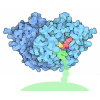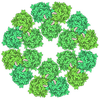+ Open data
Open data
- Basic information
Basic information
| Entry | Database: PDB / ID: 9kqc | ||||||
|---|---|---|---|---|---|---|---|
| Title | Chlorella virus Hyaluronan Synthase bound to VNAR | ||||||
 Components Components |
| ||||||
 Keywords Keywords | TRANSFERASE / Chlorella virus Hyaluronan Synthase / membrane-integrated glycosyltransferase | ||||||
| Function / homology | hyaluronan synthase activity / Glycosyltransferase like family 2 / hyaluronan biosynthetic process / Nucleotide-diphospho-sugar transferases / plasma membrane / : / URIDINE-DIPHOSPHATE-N-ACETYLGLUCOSAMINE / Hyaluronan synthase Function and homology information Function and homology information | ||||||
| Biological species |  Chlorella virus Chlorella virus Chiloscyllium plagiosum (whitespotted bambooshark) Chiloscyllium plagiosum (whitespotted bambooshark) | ||||||
| Method | ELECTRON MICROSCOPY / single particle reconstruction / cryo EM / Resolution: 3.36 Å | ||||||
 Authors Authors | Deng, P. / Zhang, X. / Xu, M. / Wen, J. / Li, P. / Bi, Y. / Wang, H. | ||||||
| Funding support |  China, 1items China, 1items
| ||||||
 Citation Citation |  Journal: J Struct Biol X / Year: 2025 Journal: J Struct Biol X / Year: 2025Title: Generation of shark single-domain antibodies as an aid for Cryo-EM structure determination of membrane proteins: Use hyaluronan synthase as an example. Authors: Penghui Deng / Xiaoyue Zhang / Jianqing Wen / Mingce Xu / Pengwei Li / Hao Wang / Yunchen Bi /  Abstract: In cartilaginous fish, the immunoglobulin new antigen receptor (IgNAR) is naturally devoid of light chains. The variable regions of IgNAR (VNARs) are solely responsible for antigen recognition, ...In cartilaginous fish, the immunoglobulin new antigen receptor (IgNAR) is naturally devoid of light chains. The variable regions of IgNAR (VNARs) are solely responsible for antigen recognition, similar to VHHs (variable domain of the heavy chain of heavy-chain antibodies) in camelids. Although VNARs have attracted growing interest, generating VNARs against membrane proteins remains challenging. Furthermore, the structure of a VNAR in complex with a membrane protein has not yet been reported. This study features a membrane protein, Chlorella virus hyaluronan synthase (CvHAS), and provides a comprehensive methodological approach to generate its specific shark VNARs, addressing several major concerns and important optimizations. We showed that shark physiological urea pressure was tolerable for CvHAS, and indirect immobilization was strongly preferred over passive adsorption for membrane proteins. Together with optimizations to improve mononuclear cell (MC) viability and VNAR expression efficiency, we successfully generated S2F6, a CvHAS-specific VNAR with nM-level high affinity. The structure of the CvHAS-S2F6 complex was then determined by cryogenic electron microscopy (cryo-EM), reporting the first membrane protein and VNAR complex structure. It shows that S2F6 binds to the cytoplasmic domain of CvHAS, with a different epitope than the reported CvHAS-specific VHHs. This study provides valuable insights into developing VNARs for membrane proteins and their applications in structural biology. | ||||||
| History |
|
- Structure visualization
Structure visualization
| Structure viewer | Molecule:  Molmil Molmil Jmol/JSmol Jmol/JSmol |
|---|
- Downloads & links
Downloads & links
- Download
Download
| PDBx/mmCIF format |  9kqc.cif.gz 9kqc.cif.gz | 133.4 KB | Display |  PDBx/mmCIF format PDBx/mmCIF format |
|---|---|---|---|---|
| PDB format |  pdb9kqc.ent.gz pdb9kqc.ent.gz | 99.2 KB | Display |  PDB format PDB format |
| PDBx/mmJSON format |  9kqc.json.gz 9kqc.json.gz | Tree view |  PDBx/mmJSON format PDBx/mmJSON format | |
| Others |  Other downloads Other downloads |
-Validation report
| Summary document |  9kqc_validation.pdf.gz 9kqc_validation.pdf.gz | 1.2 MB | Display |  wwPDB validaton report wwPDB validaton report |
|---|---|---|---|---|
| Full document |  9kqc_full_validation.pdf.gz 9kqc_full_validation.pdf.gz | 1.3 MB | Display | |
| Data in XML |  9kqc_validation.xml.gz 9kqc_validation.xml.gz | 42.9 KB | Display | |
| Data in CIF |  9kqc_validation.cif.gz 9kqc_validation.cif.gz | 61.1 KB | Display | |
| Arichive directory |  https://data.pdbj.org/pub/pdb/validation_reports/kq/9kqc https://data.pdbj.org/pub/pdb/validation_reports/kq/9kqc ftp://data.pdbj.org/pub/pdb/validation_reports/kq/9kqc ftp://data.pdbj.org/pub/pdb/validation_reports/kq/9kqc | HTTPS FTP |
-Related structure data
| Related structure data |  62500MC M: map data used to model this data C: citing same article ( |
|---|---|
| Similar structure data | Similarity search - Function & homology  F&H Search F&H Search |
- Links
Links
- Assembly
Assembly
| Deposited unit | 
|
|---|---|
| 1 |
|
- Components
Components
| #1: Protein | Mass: 65337.469 Da / Num. of mol.: 1 Source method: isolated from a genetically manipulated source Source: (gene. exp.)  Chlorella virus / Gene: CZ-2_118R, PBCVCZ2_118R / Production host: Chlorella virus / Gene: CZ-2_118R, PBCVCZ2_118R / Production host:  |
|---|---|
| #2: Protein | Mass: 14473.181 Da / Num. of mol.: 1 Source method: isolated from a genetically manipulated source Source: (gene. exp.)  Chiloscyllium plagiosum (whitespotted bambooshark) Chiloscyllium plagiosum (whitespotted bambooshark)Production host:  |
| #3: Chemical | ChemComp-UD1 / |
| #4: Chemical | ChemComp-MN / |
| Has ligand of interest | Y |
| Has protein modification | Y |
-Experimental details
-Experiment
| Experiment | Method: ELECTRON MICROSCOPY |
|---|---|
| EM experiment | Aggregation state: PARTICLE / 3D reconstruction method: single particle reconstruction |
- Sample preparation
Sample preparation
| Component | Name: Chlorella virus Hyaluronan Synthase bound to VNAR. / Type: COMPLEX / Entity ID: #1-#2 / Source: RECOMBINANT |
|---|---|
| Molecular weight | Value: 79.708 kDa/nm / Experimental value: NO |
| Source (natural) | Organism:  Chlorella virus Chlorella virus |
| Source (recombinant) | Organism:  |
| Buffer solution | pH: 6.5 |
| Specimen | Embedding applied: NO / Shadowing applied: NO / Staining applied: NO / Vitrification applied: YES |
| Vitrification | Cryogen name: ETHANE |
- Electron microscopy imaging
Electron microscopy imaging
| Microscopy | Model: FEI MORGAGNI |
|---|---|
| Electron gun | Electron source:  FIELD EMISSION GUN / Accelerating voltage: 300 kV / Illumination mode: FLOOD BEAM FIELD EMISSION GUN / Accelerating voltage: 300 kV / Illumination mode: FLOOD BEAM |
| Electron lens | Mode: BRIGHT FIELD / Nominal defocus max: 1800 nm / Nominal defocus min: 800 nm |
| Image recording | Electron dose: 50 e/Å2 / Film or detector model: FEI FALCON IV (4k x 4k) |
- Processing
Processing
| CTF correction | Type: PHASE FLIPPING AND AMPLITUDE CORRECTION |
|---|---|
| 3D reconstruction | Resolution: 3.36 Å / Resolution method: FSC 0.143 CUT-OFF / Num. of particles: 263915 / Symmetry type: POINT |
 Movie
Movie Controller
Controller



 PDBj
PDBj





